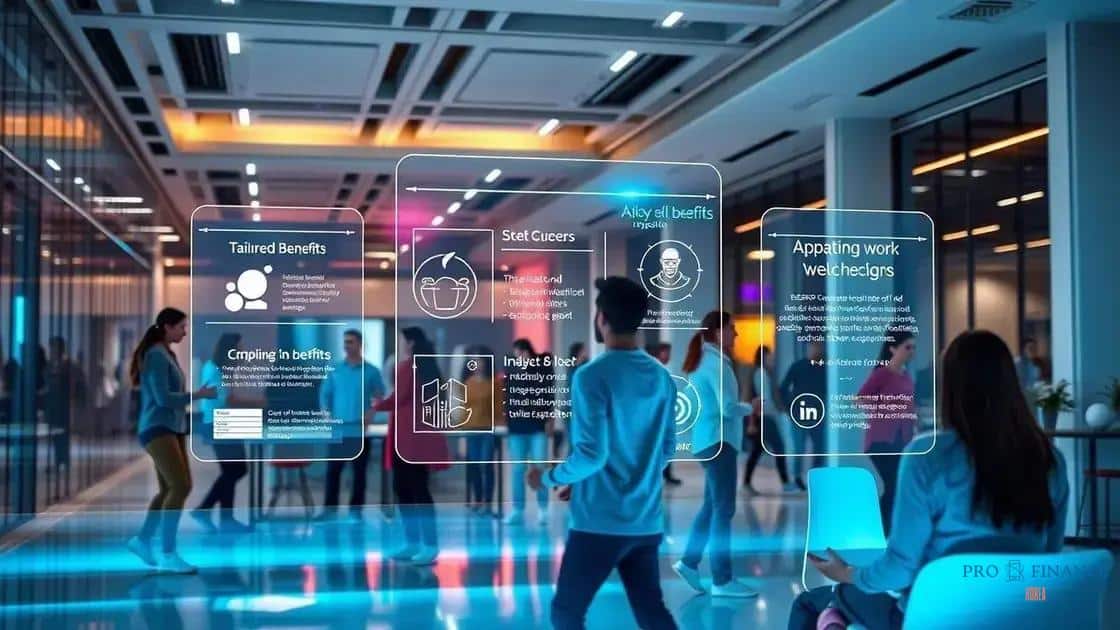How tech companies are improving employee benefits packages

Tech companies are improving employee benefits packages by focusing on wellness programs, personalized options, and enhancements for remote work, which collectively lead to higher employee satisfaction and retention.
How tech companies are improving employee benefits packages is changing the landscape of workplace dynamics. Have you noticed how some organizations seem to go the extra mile for their employees? Let’s dive into the innovative ways tech firms are reshaping employee perks.
Trends in employee benefits offerings
Employee benefits are rapidly evolving, especially in the tech sector. Companies are now acknowledging that to attract and retain the best talent, they need to offer more than just a standard benefits package. It’s important to recognize the trends in employee benefits offerings that are reshaping workplaces today.
Flexible Work Arrangements
One of the most significant shifts has been towards flexible work arrangements. Many organizations are providing options for remote work, hybrid setups, and flexible hours, allowing employees to balance their personal and professional lives more effectively.
Wellness Programs
Businesses are increasingly investing in wellness programs. These initiatives can include physical fitness activities, mental health resources, and nutritional counseling. A healthy workforce is a productive workforce.
- Gym memberships
- Access to health workshops
- Mental health days
By prioritizing wellness, companies can create a more favorable work environment, enhancing job satisfaction and loyalty.
Personalized Benefits
Another emerging trend is the move towards personalized benefits. This means companies are customizing benefits packages to fit individual employee needs. For instance, some might prefer greater health coverage, while others value additional vacation time.
This personalization fosters a sense of belonging and demonstrates that employers genuinely care about their workforce.
Increased Paid Leave Options
In addition, organizations are expanding their paid leave options. Many are offering enhanced parental leave, sabbaticals, and even bereavement leave. Providing greater time off helps employees manage life events without the added stress of job insecurity.
Diversity and Inclusion Initiatives
Lastly, companies recognize that employee benefits should promote diversity and inclusion. This can include resources for underrepresented groups or programs that foster an inclusive workplace culture. By supporting all employees, companies can build a more innovative and cohesive environment.
Overall, staying ahead of these trends is vital for organizations aiming to create a competitive advantage in the job market. Adapting to these changes can lead to happier employees and better business outcomes.
Technology’s role in customizing benefits packages
Technology plays a crucial role in customizing benefits packages for employees. By utilizing advanced software and platforms, companies can assess individual needs effectively and tailor their offerings accordingly. This enhances employee satisfaction and ensures that everyone feels valued.
Data-Driven Insights
Using data-driven insights is key to personalizing benefits. Many tech companies leverage analytics tools to understand which benefits employees truly desire. Surveys and usage data help organizations identify trends and preferences.
- Analyzing employee demographics
- Tracking benefits usage
- Gathering feedback regularly
This information allows companies to adjust their benefits offerings, making them more relevant to the workforce.
AI and Machine Learning
Another way technology is influencing benefits is through artificial intelligence and machine learning. These tools can analyze vast amounts of data and predict individual employee needs based on their usage patterns. AI can suggest personalized benefits that fit unique lifestyles.
Employee Self-Service Platforms
Employee self-service platforms empower workers to choose their own benefits. By offering an easy-to-use interface, tech companies enable employees to customize their packages. This approach promotes engagement and satisfaction because employees can select what matters most to them.
Integration with HR Systems
Incorporating technology enhances how benefits integrate with existing HR systems. Having a seamless connection allows for easy access to information and services. Employees can view their benefits, make changes, and get assistance all in one place.
Ultimately, embracing technology in customizing benefits packages is essential for attracting and retaining top talent. It creates a positive, inclusive work environment that meets the diverse needs of today’s workforce.
Impact of remote work on employee benefits
The rise of remote work has significantly changed the landscape of employee benefits. As more organizations adopt flexible work arrangements, it’s essential to understand the impact of remote work on employee benefits and how it affects employee satisfaction.
Shift in Benefits Priorities
With employees working from home, there is a noticeable shift in benefits priorities. Many workers now value benefits that support a remote lifestyle. For instance, companies are increasingly offering technology stipends, home office equipment, and better internet reimbursements.
- Home office setup allowances
- Monthly stipends for technology
- Increased access to virtual health services
This adjustment reflects the necessity of having the right tools to be productive while working remotely.
Wellness and Mental Health Support
The need for wellness and mental health support is also amplified in a remote setting. Employees may experience feelings of isolation, leading companies to enhance their support in this area. Mental health days and virtual counseling services have become increasingly important.
Flexible Scheduling
Remote work has prompted more organizations to embrace flexible scheduling. Employees appreciate the ability to manage their time better, blending personal and professional responsibilities. This flexibility often leads to improved work-life balance and higher job satisfaction.
As remote work continues to evolve, companies are recognizing that employee benefits must adapt as well. Providing benefits that cater to the needs of remote workers can significantly improve loyalty and retention.
The Role of Communication Tools
Moreover, the role of communication tools cannot be overlooked. Employers are increasingly using platforms for virtual meetings, team collaboration, and social interaction. Providing subscriptions to these tools can enhance team cohesion and ensure that employees feel connected.
In summary, embracing the impact of remote work on employee benefits can help companies create a more supportive work environment, addressing the unique challenges that remote employees face.
Future predictions for employee benefits

The future of employee benefits is an exciting topic, as it is heavily influenced by both technological advancements and changing workforce expectations. As we look ahead, there are meaningful predictions for employee benefits that organizations should consider to stay competitive.
Increased Focus on Wellness
One major trend is the increased focus on wellness programs. Employers understand the importance of mental and physical health. This means more companies will likely offer comprehensive health plans, including mental health resources, fitness programs, and wellness initiatives.
- Access to mental health professionals
- Fitness class reimbursements
- Nutrition counseling services
Providing these services can lead to happier and healthier employees, ultimately benefiting the organization.
Emphasis on Work-Life Balance
Future employee benefits will also put a stronger emphasis on work-life balance. As remote work remains prevalent, companies are expected to offer more flexible schedules and additional paid time off. This flexibility can help employees manage their personal and professional lives more effectively.
Personalized Benefits Options
Moreover, there will likely be a shift towards more personalized benefits options. Each employee has unique needs, and customizing benefits to fit those needs will become a standard practice. This could mean the ability to choose from various benefits like childcare, wellness stipends, or additional vacation days.
Employees will have the power to select what works best for them, increasing job satisfaction and retention.
Technology Integration
Another key prediction is the continued integration of technology into benefits administration. Tools for managing benefits will become more user-friendly and accessible. Artificial intelligence may streamline processes, making it easier for employees to understand their options and enroll in the programs that suit them.
As technology evolves, so do the possibilities for employee benefits. Companies must remain adaptable to meet the ever-changing needs of their workforce.
Overall, keeping an eye on these future predictions for employee benefits will help organizations create an attractive workplace that promotes employee well-being and loyalty.
Case studies of successful companies
Examining case studies of successful companies can provide valuable insights into how they enhance employee benefits. These examples highlight innovative strategies and real-life results, showcasing the impact of effective benefits packages on workplace culture.
Tech Giants Leading the Way
Many tech giants have set the standard for employee benefits. For instance, Google is known for its comprehensive benefits that include healthcare, on-site wellness services, and generous parental leave policies. These offerings have resulted in high employee satisfaction and retention rates.
Netflix and Unlimited Vacation
Another prime example is Netflix, which offers an innovative unlimited vacation policy. This approach allows employees to take time off as needed, fostering a culture of trust and responsibility. Research shows that this policy has led to increased productivity and employee loyalty.
Salesforce and Mental Health Support
Salesforce is a great case for mental health support integration. The company provides mental health days and access to counseling services, emphasizing holistic well-being. Their approach has shown positive effects on employee morale and mental health overall.
Remote Work Adaptations by Microsoft
Microsoft has adapted its employee benefits to support remote work. By offering home office stipends and flexible work hours, they cater to employee needs during this transition. Employees report feeling valued and supported, which enhances their performance and job satisfaction.
These case studies illustrate how successful companies focus on tailoring benefits to meet the unique needs of their workforce. Implementing similar strategies can lead to improved employee engagement, productivity, and loyalty across industries.
FAQ – Frequently Asked Questions about Employee Benefits
What are the main trends in employee benefits today?
Main trends include increased focus on wellness programs, personalized benefit options, and support for remote work.
How can technology improve employee benefits?
Technology can provide data-driven insights, streamline benefits administration, and enhance communication between employers and employees.
Why are case studies important when discussing employee benefits?
Case studies offer real-world examples of successful companies that effectively implement employee benefits, providing valuable insights and inspiration.
How can companies adapt their benefits for remote workers?
Companies can offer home office stipends, flexible scheduling, and enhanced virtual wellness resources to better support remote employees.






